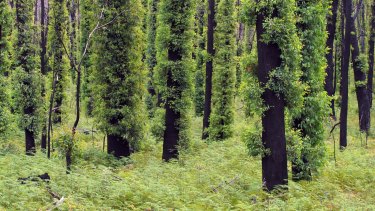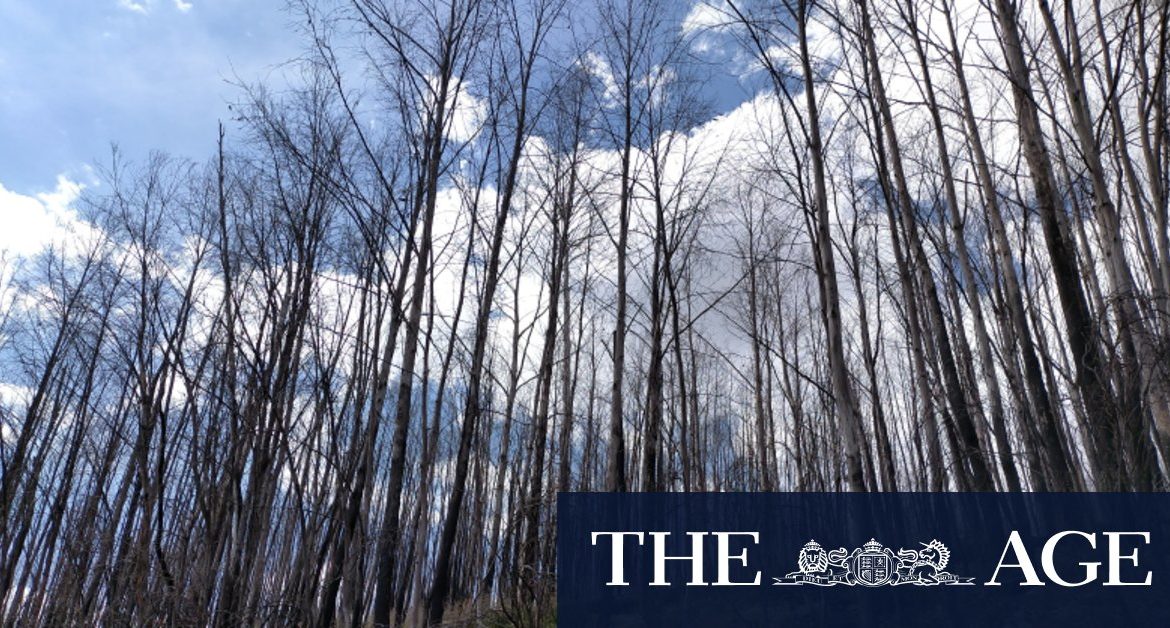The drought that preceded the record-breaking blazes was so intense that forests’ capacity to bounce back to health has been greatly reduced.
The fires burnt over such a vast range of more than 10 million hectares there were few unburnt refuges from which plants and animals can emerge to repopulate the fire grounds.
Logging has also taken a toll, by reducing the overall condition of the forest estate, removing the ecologically significant large trees and disrupting old growth forest.
Ongoing salvage logging in burnt forest also takes a heavy toll on soil health and streams as well as removing logs that are important habitat for native animals.
“It’s wonderful to see the green growth back in the forests,” ANU Professor David Lindenmayer said. “But there are some underlying issues that are creating real problems and I have massive concerns about what we will see there in 20 years time.”
Loading
Governments are scrambling to collect millions of seeds in an effort to help regrow the wet eucalypt forests in Victoria, and in dry eucalypt forests, which run down to the coast, there is a need to stop the spread of invasive weeds as well as predation by feral animals.
“Our ecosystems have not been geared up to deal with the high frequency and severity of these disturbances. It’s burning far too often now,” Professor Lindenmayer said.
“This century we’ve had three megafires (over 1 million hectares) on the east coast, in 2009, 2014 and 2020. But in the century before that there was one, and in the century before that we also just had one.”
Some of the most acute impacts from Black Summer are in the alpine ash forests of the Snowy Mountains and north-eastern Victoria.
These forests have evolved to cope with fires that occur no more frequently than once every 75 years, but they were torched in 2003 and again last summer. When alpine ash burns too frequently, the young trees that remain do not produce viable seed to allow the forest to bounce back.
Wattle seeds, which lay dormant in the soil, are triggered into prolific growth by hot fires and out-compete the sub-alpine forests.
Trees in a dry eucalypt forest regrow by sprouting shoots from their trunk – known as epicormic growth.
“There’s a big risk now the wetter forests across huge swathes of Victoria and southern NSW won’t be able to recover,” Professor Lindenmayer said.
In fact, most tree species in wet eucalypt forests re-sprout from seeds. The lack of big trees, which are only found in old growth forests, is a key risk to forest recovery.
Big trees produce the vast majority of a species’ seeds, pollen, flowers and nectar, as well as create the habitat relied on by more than 300 species of vertebrate animals.
A 2019 study by Professor Lindenmayer and Dr Chris Taylor of the Fenner School of Environment found that in Victoria there were 833,000 hectares of old growth forest in 2000, or 11 per cent of the native forest estate. But by 2020, 77 per cent, or 640,000 hectares, had been disturbed by bushfires, logging or a combination of both.
Vigorous re-sprouting is visible in the coastal forests, which from south-east Queensland to Gippsland in Victoria extend eastward from the ranges down the coast.

Timely rain has helped south-eastern Australia’s forests regrow after the Black Summer fires.
Trees in dry eucalypt forests, which are adapted to hotter and more frequent fires, don’t shed seeds like their relatives in the wetter forests – they re-sprout shoots from their trunks – which is known as epicormic growth.
But in some places even these trees are struggling now.
“There is a limit to the number of times it can be cooked and re-sprout. Younger, smaller trees are particularly vulnerable,” Professor Lindenmayer said.
“For example, when you drive from Nowra (on the NSW South Coast) to Batemans Bay or from Canberra down Clyde Mountain, and you look into the beautiful forest of spotted gum and coastal blackbutt, you will struggle to see a big tree.”
Mike is the climate and energy correspondent for The Age and The Sydney Morning Herald.
Most Viewed in National
Loading







